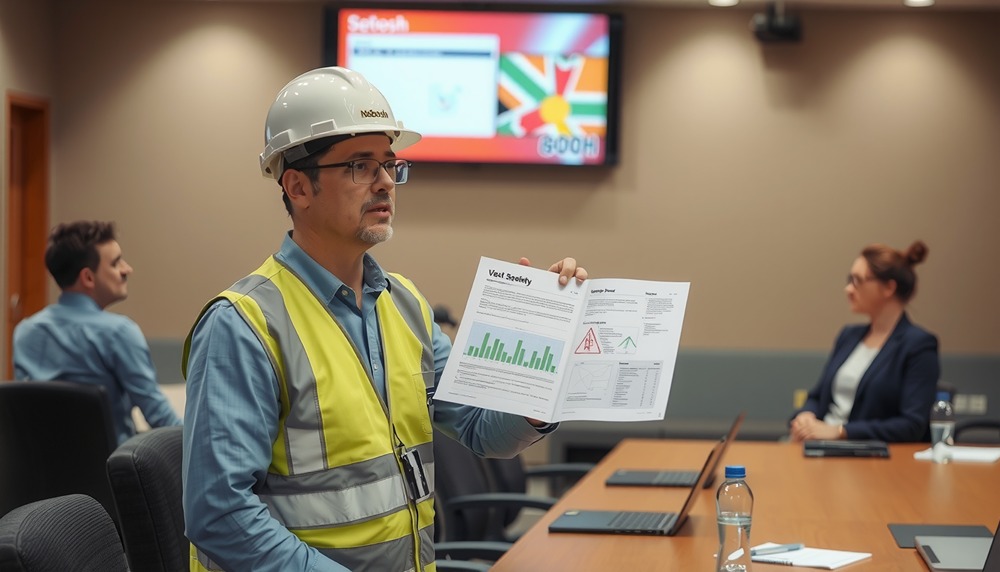Is ascending to the top echelons of the construction industry on your career agenda? The NVQ Level 7 in Construction Management could be your stepping stone to strategic leadership within high-value projects. This qualification, parallel in prestige to a Master’s degree, is tailored for professionals aspiring to command roles such as project manager and operations director. Offering a concentrated focus on business management and leadership, the NVQ Level 7 prepares you to not only manage but influence and direct the course of complex construction undertakings. Dive into discovering how this credential can elevate your professional journey.
Overview of NVQ Level 7 in Construction Management
The NVQ Level 7 in Construction Management is a qualification tailored for individuals aiming to excel in senior roles within the construction industry. It is recognised as being equivalent to a Master’s degree, providing an advanced level of education and skills development. This qualification focuses on enhancing the expertise required to manage high-value or complex projects, equipping professionals with the necessary competencies to lead and innovate in the field of construction management.
This qualification is particularly beneficial for roles such as project managers, contracts managers, and operations directors. These positions require a profound understanding of the construction process, coupled with the ability to oversee multiple facets of project execution. The NVQ Level 7 provides the comprehensive knowledge and leadership skills needed to effectively manage and direct large-scale projects, making it an ideal choice for those aiming to ascend to senior management levels in the construction sector.
Strategic leadership and business management are at the core of the NVQ Level 7 curriculum. The programme covers critical areas such as project governance, commercial control, and workforce planning. It seeks to develop the strategic acumen and decision-making abilities essential for senior professionals tasked with steering organisations towards success. This focus on strategic elements ensures that candidates are well-prepared to tackle the challenges of the modern construction environment, driving growth and innovation within their organisations.
NVQ Level 7 Course Structure and Modules
The NVQ Level 7 in Construction Management is meticulously structured to provide a comprehensive educational framework for senior management professionals. The course consists of 6 mandatory units that form the core of the programme, ensuring that every candidate gains essential knowledge and skills in fundamental areas. Additionally, there are 13 optional units from which candidates must complete 4 to 5, allowing them to tailor their learning to specific interests or career paths. To achieve the qualification, candidates need to accumulate a total of 62 credits, reflecting the depth and breadth of the learning experience.
Key topics covered in the NVQ Level 7 modules include:
- Project governance
- Commercial control
- Ethical decision-making
- Workforce planning
These topics are integral to developing the strategic competencies necessary for high-level roles in construction management. Project governance ensures that candidates can oversee projects with a clear, structured approach, while commercial control equips them with the skills to manage financial aspects efficiently. Ethical decision-making is crucial in today’s business environment, fostering integrity and responsibility. Workforce planning focuses on optimising human resources, ensuring that teams are effectively managed and aligned with organisational goals.
The qualification follows a practical, work-based approach, emphasising real-world application over theoretical study. This method involves compiling a portfolio of evidence that demonstrates the candidate’s competencies and experiences in their professional role. By engaging directly with their work environment, candidates can contextualise learning and apply new skills immediately, enhancing both their personal development and the operational success of their organisations. This practical focus ensures that graduates of the NVQ Level 7 are not only knowledgeable but also capable of implementing effective strategies in the dynamic field of construction management.
Eligibility Criteria and Application Process for NVQ Level 7

To enrol in the NVQ Level 7 in Construction Management, candidates must meet specific eligibility criteria. A key requirement is having at least two years of relevant experience in a construction management role. This experience ensures that candidates possess the foundational knowledge and practical skills necessary to benefit from the advanced content of the qualification. Additionally, an initial assessment of literacy and numeracy is conducted to verify that applicants can effectively engage with the course material and assessments.
The application process for NVQ Level 7 involves submitting essential documentation to establish a candidate’s suitability for the programme. Prospective candidates must complete a candidate statement, outlining their motivations and goals for pursuing the qualification. Additionally, a Declaration of Own Work form is required, affirming the authenticity and originality of any submitted work. These documents are vital for aligning the candidate’s experience and aspirations with the course objectives.
The steps in the application process are straightforward yet comprehensive. Candidates begin by preparing the necessary documentation and completing the initial assessments. Once these are submitted and reviewed, successful applicants are enrolled into the programme. Throughout this process, applicants may receive guidance and support to ensure that all requirements are met efficiently. This structured approach helps streamline the transition into the NVQ Level 7, allowing candidates to focus on their educational and career advancement goals.
NVQ Level 7 Assessment Methods
The NVQ Level 7 in Construction Management relies on a portfolio-based assessment process, distinguishing it from traditional exam-based evaluations. Candidates are required to compile a portfolio of evidence demonstrating their competency and practical experience in the field. This method is designed to reflect real-world proficiency, allowing candidates to showcase their skills and knowledge through tangible work examples. The portfolio approach ensures that the assessment is tailored to the individual’s professional practice, providing a comprehensive evaluation of their ability to manage complex construction projects.
- Project reports
- Professional evaluations
- Documentation of previous work
The assessment process typically involves two sessions, which may include a site visit to further validate the candidate’s practical experience. These sessions are integral to the evaluation, offering opportunities for candidates to discuss their portfolio with assessors and receive feedback. The potential site visit allows assessors to observe the candidate’s skills in a real-world context, providing a deeper insight into their capabilities. This combination of portfolio evidence and interactive sessions ensures a thorough and holistic assessment of the candidate’s qualifications and readiness for senior roles in construction management.
Costs and Funding Options for NVQ Level 7
The NVQ Level 7 in Construction Management presents a clear cost structure designed to accommodate various financial situations. The total cost of the qualification encompasses registration fees and guidance for the fast-track MCIOB application, providing a comprehensive package for candidates. To facilitate affordability, payment plans are available, starting from £191.25 per month. This option allows candidates to spread the cost over time, easing the financial burden and making the qualification accessible to a wider range of professionals.
| Funding Option | Details |
|---|---|
| CITB Grant | Eligible companies can claim a £1,500 grant upon completion. |
| Monthly Payment Plans | Starting from £191.25 per month, making the cost manageable. |
| Fast-track MCIOB Application | Guidance included in the qualification cost. |
The financial benefits of completing the NVQ Level 7 extend beyond the qualification itself. By accessing the CITB grant, registered companies can significantly reduce the overall expense. Furthermore, the enhanced credentials obtained through the fast-track MCIOB application can lead to better job prospects and potentially higher salaries. These financial incentives not only offset the initial investment but also contribute to long-term career growth and stability in the construction industry.
Career Advancement and Opportunities Post NVQ Level 7

What roles and leadership opportunities become available after completing the NVQ Level 7 in Construction Management? The qualification opens pathways to senior leadership and director-level positions within the construction industry. It equips candidates with the strategic and managerial expertise needed to oversee complex projects and lead teams effectively. These roles often demand a comprehensive understanding of construction management, including project governance, commercial control, and workforce planning, all of which are covered in the NVQ Level 7 curriculum.
- Senior leadership roles
- Director-level positions
- Eligibility for CSCS Black ‘Manager’ card
- Enhanced strategic management skills
- Improved job prospects
How does the qualification affect career prospects? Successful candidates gain eligibility to apply for the CSCS Black ‘Manager’ card, a credential that significantly enhances their professional standing and facilitates access to more advanced job opportunities. The NVQ Level 7 also provides enhanced strategic management skills, which are crucial for handling the evolving challenges in the construction industry. Consequently, individuals who complete this qualification often experience improved job prospects, with the potential for increased responsibilities and remuneration.
Testimonials from candidates highlight the substantial career progression and knowledge enhancement achieved through the NVQ Level 7. Many individuals report a marked improvement in their ability to manage high-stakes projects and lead teams with confidence. These success stories underscore the qualification’s impact, not only in terms of personal growth but also in professional advancement. The NVQ Level 7 is thus a powerful catalyst for career transformation, equipping construction professionals with the skills and credentials needed to ascend to the highest echelons of their field.
Final Words
Attaining NVQ Level 7 in Construction Management equips professionals with advanced strategic skills essential for senior roles in the construction industry.
The course design, with both mandatory and optional modules, ensures comprehensive coverage of necessary competencies, including project governance and ethical decision-making.
The practical, work-based approach of the qualification, combined with diverse assessment methods, further enriches the learning experience.
Overall costs are balanced by funding options, making the programme accessible.
Graduates can expect to seize enhanced career opportunities and benefit significantly from their investment in this Level 7 qualification.

A cultural writer specializing in music events, Hannah explores festival experiences, artist spotlights, and tips for making the most of music festivals.




